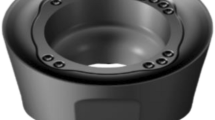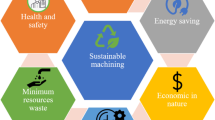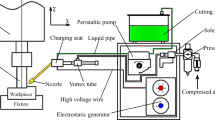Abstract
Silicon aluminum alloy with Si weight percentage in 50% (Al-50wt% Si) is a typical difficult-to-machine composite. In order to improve its machinability, it is necessary to optimize the friction state at the tool-Si-Al alloy interface by cooling/lubrication. Using appropriate cooling and lubricating media can drive machining operations towards cleaner and more sustainable targets. However, the synergy between Si-Al alloy special material structure, material properties, and multiphase coolants/lubricants is still unknown. In this study, the machining performance of Al-50wt% Si alloy under three milling environments (MEs), namely, dry, supercritical carbon dioxide (scCO2), supercritical carbon dioxide–based minimum quantity lubrication (scCO2-MQL), was discussed. The theoretical analysis was made to understand the scCO2-MQL permeation mechanism. The effects of various cutting parameters and MEs on cutting force, cutting temperature, surface roughness, and surface morphology were investigated. The results show that the lowest cutting force and temperature can be found in scCO2-MQL ME owing to its excellent cooling/lubrication and heat transfer performance. The scCO2-MQL coolant/lubricant can inhibit the spalling and crushing of Si particles. Therefore, the lowest surface roughness which is reduced by 32.34% compared with dry milling and the best surface morphology can be obtained in scCO2-MQL milling. An interaction model between tool cutting edge-Si particles in scCO2/scCO2-MQL MEs has also been presented. The results indicate that the performance of scCO2-MQL as a clean and sustainable cooling/lubrication technique can result in an appreciable improvement in milling Al-50wt% Si alloy.
















Similar content being viewed by others
Availability of data and material
The data and material in this paper are original, available, and objective.
Code availability
Not applicable.
Abbreviations
- Al-50wt% Si:
-
Silicon aluminum alloy with Si weight percentage in 50%
- ME:
-
Milling environment
- scCO2 :
-
Supercritical carbon dioxide
- MQL:
-
Minimum quantity lubrication
- scCO2-MQL:
-
Supercritical carbon dioxide based minimum quantity lubrication
- LN2 :
-
Liquid nitrogen
- scCO2-WMQL:
-
ScCO2-based MQL with water-based cutting fluid
- scCO2-OoWMQL:
-
ScCO2-based MQL with oil-on-water droplets cutting fluid
- LCO2 :
-
Liquid carbon dioxide
- Q :
-
Heat transfer quantity per unit time
- α :
-
Convective heat transfer coefficient
- S :
-
Dynamic heat transfer area
- Δt :
-
Temperature difference between the cooling medium and the cutting zone
- v c :
-
Cutting speed, m/min
- f z :
-
Feed rate, mm/z
- a p :
-
Axial cutting depth, mm
- ae :
-
Radial cutting depth, mm
- R a :
-
Arithmetic mean deviation, μm
- S :
-
Total bearing area
- F P :
-
Resistance produced by tiny furrows on the workpiece
- F :
-
Friction between the tool-chip and the tool-workpiece
- A :
-
Total bearing area
- β :
-
Percentage of the direct contact zone to the total bearing area
- τ s :
-
Surface shear strength of Si-Al alloy
- τ l :
-
Surface shear strength of scCO2-MQL fluid
- F y :
-
Feed component of cutting force, N
- Q cd :
-
Conduction
- Q nc :
-
Natural convection
- Q cv :
-
Forced convection
- Q su :
-
Sublimation
- Q ev :
-
Evaporation
- r ε :
-
Tool nose radius, μm
References
Hu F, Sun JF, Wei JQ, Zhang Y, Jia YD, Zhao YR, Liu TY (2013) Research on the process of high silicon aluminum alloy in MEDM. Adv Mater Res 634–638:1766–1770. https://doi.org/10.4028/www.scientific.net/AMR.634-638.1766
Wang S, Fu M, Li X, Wang J, Su X (2018) Microstructure and mechanical properties of Al-Si eutectic alloy modified with Al-3P master alloy. J Mater Process Technol 255:105–109. https://doi.org/10.1016/j.jmatprotec.2017.12.008
Pramanik A (2014) Developments in the non-traditional machining of particle reinforced metal matrix composites. Int J Mach Tool Manuf 86:44–61. https://doi.org/10.1016/j.ijmachtools.2014.07.003
Chen Z, Zhou H, Yan Z, Han F, Yan H (2021) Machining characteristics of 65 vol.% SiCp/Al composite in micro-WEDM. Ceram Int 47(6):13533–13543. https://doi.org/10.1016/j.ceramint.2021.01.212
Niu Q, Jing L, Li C, Yu Z, Li S, Li P, Qiu X, Ko TJ, Yue W (2021) Study on effects of tool nose radius on the formation mechanism of edge defects during milling SiCp/Al composites. Int J Adv Manuf Technol 114(9). https://doi.org/10.1007/s00170-021-07018-1
Sharma J, Sidhu BS (2014) Investigation of effects of dry and near dry machining on AISI D2 steel using vegetable oil. J Clean Prod 66(2):619–623. https://doi.org/10.1016/j.jclepro.2013.11.042
Setti D, Sinha MK, Ghosh S, Venkateswara Rao P (2015) Performance evaluation of Ti6Al4V grinding using chip formation and coefficient of friction under the influence of nanofluids. Int J Mach Tool Manuf 88:237–248. https://doi.org/10.1016/j.ijmachtools.2014.10.005
Cao T, Liu Y, Xu Y (2019) Cutting performance of tool with continuous lubrication at tool-chip interface. Int J Pr Eng Man-GT 7(5–8):347–359. https://doi.org/10.1007/s40684-019-00114-4
Gajrani KK, Suvin PS, Kailas SV, Sankar MR (2019) Hard machining performance of indigenously developed green cutting fluid using food cooling and minimum quantity cutting fluid. J Clean Prod 206:108–123. https://doi.org/10.1016/j.jclepro.2018.09.178
Tazehkandi AH, Pilehvarian F, Davoodi B (2014) Experimental investigation on removing cutting fluid from turning of Inconel 725 with coated carbide tools. J Clean Prod 80(1):271–281. https://doi.org/10.1016/j.jclepro.2014.05.098
Rahim EA, Ibrahim MR, Rahim AA, Aziz S, Mohid Z (2015) Experimental investigation of minimum quantity lubrication (MQL) as a sustainable cooling technique. Procedia CIRP 26:351–354. https://doi.org/10.1016/j.procir.2014.07.029
Hegab H, Kishawy HA, Darras B (2019) Sustainable cooling and lubrication strategies in machining processes: a comparative study. Procedia Manuf 33:786–793. https://doi.org/10.1016/j.promfg.2019.04.099
Gong L, Bertolini R, Bruschi S, Ghiotti A, He N (2021) Surface integrity evaluation when turning Inconel 718 alloy using sustainable lubricating-cooling approaches. Int J Pr Eng Man-GT. https://doi.org/10.1007/s40684-021-00310-1
Khanna N, Shah PC (2020) Comparative analysis of dry, flood, MQL and cryogenic CO2 techniques during the machining of 15–5-PH SS alloy. Tribol Int 146:106196. https://doi.org/10.1016/j.triboint.2020.106196
Rahim EA, Rahim AA, Ibrahim MR, Mohid Z (2016) Performance of turning operation by using supercritical carbon dioxide (scCO2) as a cutting fluid. ARPN J Eng Appl Sci 11(14):8609–8613
Rahim EA, Rahim AA, Ibrahim MR, Mohid Z (2016) Experimental investigation of supercritical carbon dioxide (scCO2) performance as a sustainable cooling technique. Procedia CIRP 40:638–642. https://doi.org/10.1016/j.procir.2016.01.147
Saberi A, Rahimi AR, Parsa H, Ashrafijou M, Rabiei F (2016) Improvement of surface grinding process performance of CK45 soft steel by minimum quantity lubrication (MQL) technique using compressed cold air jet from vortex tube. J Clean Prod 131:728–738. https://doi.org/10.1016/j.jclepro.2016.04.104
Race A, Zwierzak I, Secker J, Walsh J, Maurotto A (2020) Environmentally sustainable cooling strategies in milling of SA516: effects on surface integrity of dry, flood and MQL machining. J Clean Prod 288:125580. https://doi.org/10.1016/j.jclepro.2020.125580
Zhu G, Yuan S, Kong X, Zhang C, Chen B (2020) Experimental observation of oil mist penetration ability in minimum quantity lubrication (MQL) spray. J Mech Sci Technol 34(8):1–9. https://doi.org/10.1007/s12206-020-0713-3
Yuan SM, Yan LT, Liu WD, Liu Q (2011) Effects of cooling air temperature on cryogenic machining of Ti-6Al-4V alloy. J Mater Process Technol 211(3):356–362. https://doi.org/10.1016/j.jmatprotec.2010.10.009
Stephenson DA, Skerlos SJ, King AS, Supekar SD (2014) Rough turning Inconel 750 with supercritical CO2-based minimum quantity lubrication. J Mater Process Technol 214(3):673–680. https://doi.org/10.1016/j.jmatprotec.2013.10.003
Pervaiz S, Anwar S, Qureshi I, Ahmed N (2019) Recent advances in the machining of titanium alloys using minimum quantity lubrication (MQL) based techniques. Int J Pr Eng Man-GT 6(1):133–145. https://doi.org/10.1007/s40684-019-00033-4
Kummam Ka Ndath A, Duchosal A, Morandeau A, Leroy R (2021) Mechanical and thermal load effects of novel MWFs delivery method in milling of Ti-6Al-4V. Int J Pr Eng Man-GT. https://doi.org/10.1007/s40684-020-00288-2
Bagherzadeh A, Budak E (2018) Investigation of machinability in turning of difficult-to-cut materials using a new cryogenic cooling approach. Tribol Int 119:510–520. https://doi.org/10.1016/j.triboint.2017.11.033
Cai C, Liang X, An Q, Tao Z, Ming W, Chen M (2020) Cooling/lubrication performance of dry and supercritical CO2-based minimum quantity lubrication in peripheral milling Ti-6Al-4V. Int J Pr Eng Man-GT 8(5):405–421. https://doi.org/10.1007/s40684-020-00194-7
An Q, Cai C, Zou F, Liang X, Chen M (2020) Tool wear and machined surface characteristics in side milling Ti-6Al-4V under dry and supercritical CO2 with MQL conditions. Tribol Int 151:106511. https://doi.org/10.1016/j.triboint.2020.106511
Othman K, Ghani JA, Afifah J, Rahman HA, Amin NS (2018) Tool life and surface roughness of A390 aluminum alloy in milling process under dry and cryogenic conditions. Int J Eng Technol 7(4.36):432–435. https://doi.org/10.14419/ijet.v7i4.36.28156
Kelly JF, Cotterell MG (2002) Minimal lubrication machining of aluminium alloys. J Mater Process Technol 120(1):327–334. https://doi.org/10.1016/S0924-0136(01)01126-8
Bhowmick S, Alpas AT (2008) Minimum quantity lubrication drilling of aluminium-silicon alloys in water using diamond-like carbon coated drills. Int J Mach Tool Manuf 48(12–13):1429–1443. https://doi.org/10.1016/j.ijmachtools.2008.04.010
Chen D, Yasuo S, Katsuhiko S (2000) Effect of using small amount of lubricating oil and cold air cooling on the quality of machining surface of high-silicon aluminum alloy. Chin J Mech Eng-EN 36(11):70–74
Pei H, Shen C, Huang J, Wang G (2017) Flow field characteristics of the wedge zone between a major flank and a transient surface. Int J Adv Manuf Technol 92(1):1–9. https://doi.org/10.1007/s00170-017-0489-5
Zhong W (2014) Effects of heat transferring parameter on cutting heat transferring under the condition of cutting fluid cooling. Technol Test 10:98–101. https://doi.org/10.3969/j.issn.1005-2402.2014.10.025
Zhang J, Meng Y (2015) Boundary lubrication by adsorption film Friction 3(2):115–147. https://doi.org/10.1007/s40544-015-0084-4
Wu S, Liao H, Li S, Bi J, Li Z (2020) High-speed milling of hardened mold steel P20 with minimum quantity lubrication. Int J Pr Eng Man-GT (1–4). https://doi.org/10.1007/s40684-020-00249-9
Pang M, Liu X, Jiao Y, Liu K (2018) Fluid infiltration characteristics and driving mechanism in the rubber-glass contact interface. Appl Math Mech 39(2):137–146. https://doi.org/10.21656/1000-0887.380053
Carbone G, Lorenz B, Persson B, Wohlers A (2009) Contact mechanics and rubber friction for randomly rough surfaces with anisotropic statistical properties. Eur Phys J E - Soft Matter 29(3):275–284. https://doi.org/10.1140/epje/i2009-10484-8
Duan C, Sun W, Fu C, Zhang F (2018) Modeling and simulation of tool-chip interface friction in cutting Al/SiCp composites based on a three-phase friction model. Int J Mech Sci 142–143:384–396. https://doi.org/10.1016/j.ijmecsci.2018.05.014
Muraki M (2007) Tribological properties of aluminum-silicon alloy lubricated with biodegradable lubricants. J Jpn Soc Tribologists 52(7):525–532
Safari H, Sharif S, Izman S, Jafari H (2015) Surface integrity characterization in high-speed dry end milling of Ti-6Al-4V titanium alloy. Int J Adv Manuf Technol 78(1):651–657. https://doi.org/10.1007/s00170-014-6653-2
Masoudi S, Esfahani MJ, Jafarian F, Mirsoleimani SA (2019) Comparison the effect of MQL, wet and dry turning on surface topography, cylindricity tolerance and sustainability. Int J Pr Eng Man-GT 6(2):100–113. https://doi.org/10.1007/s40684-019-00042-3
Dhananchezian M, Kumar MP (2011) Cryogenic turning of the Ti-6Al-4V alloy with modified cutting tool inserts. Cryogenics 51(1):34–40. https://doi.org/10.1016/j.cryogenics.2010.10.011
Jeong MWC (2001) New cooling approach and tool life improvement in cryogenic machining of titanium alloy Ti-6Al-4V. Int J Mach Tool Manuf 41(15):2245–2260. https://doi.org/10.1016/S0890-6955(01)00041-4
Duan C, Liu Y, Wei S (2019) Effect of cutting parameters on deformation of cutting SiCp/Al composites. Tool Eng 53(1):20–24. https://doi.org/10.3969/j.issn.1000-7008.2019.01.004
Wang Y, Murga A, Long Z, Yoo SJ, Ito K (2020) Experimental study of oil mist characteristics generated from minimum quantity lubrication and flood cooling. Energy Built Environ 2(1). https://doi.org/10.1016/j.enbenv.2020.05.005
Pramanik A, Zhang LC, Arsecularatne JA (2008) Machining of metal matrix composites: Effect of ceramic particles on residual stress, surface roughness and chip formation. Int J Mach Tool Manuf 48(15):1613–1625. https://doi.org/10.1016/j.ijmachtools.2008.07.008
Jiang XK, Yu H, Xu ZF, Liu J, Cai CC (2018) Effect of cryogenic treatment time on residual stress and mechanical properties of 3D-Cf/Al composites. Cailiao Rechuli Xuebao/Trans Mater Heat Treat 39(10):1–7. https://doi.org/10.13289/j.issn.1009-6264.2018-0250
Pramanik A, Zhang LC, Arsecularatne JA (2007) An FEM investigation into the behavior of metal matrix composites: tool-particle interaction during orthogonal cutting. Int J Mach Tool Manuf 47(10):1497–1506. https://doi.org/10.1016/j.ijmachtools.2006.12.004
Funding
This work is supported by the National Natural Science Foundation of China (No. 52075168, 51605161, 51775184), the Project of Department of Education of Hunan Province (No. 19B190), and the Scientific Research Fund of Hunan University of Science and Technology (No. KJ-2042).
Author information
Authors and Affiliations
Contributions
Lu Jing: Conceptualization, methodology, investigation, data curation, writing—original draft. Qiulin Niu: Conceptualization, methodology, funding acquisition, writing—review and editing. Jiaqiang Dang: Investigation, supervision, writing—review and editing. Qinglong An: Conceptualization, validation. Chunhao Wang: Investigation, supervision. Fan Zou: Investigation, supervision. Changping Li: Methodology, writing—review and editing. Pengnan Li: Supervision, funding acquisition. Wenhui Yue: Supervision. Tae Jo Ko: Funding acquisition, writing—review and editing.
Corresponding authors
Ethics declarations
Ethical approval
Not applicable.
Consent to participate
Not applicable.
Consent for publication
We would like to submit the manuscript entitled “Milling performance evaluation and cooling/lubrication mechanism of Al-50wt% Si alloy based on various environmentally sustainable manufacturing strategies” by Lu Jing, Qiulin Niu, Jiaqiang Dang, Qinglong An, Chunhao Wang, Fan Zou, Changping Li, Pengnan Li, Wenhui Yue, Tae Jo Ko, and we wish it to be considered for publication in the International Journal of Advanced Manufacturing Technology.
Competing interests
The authors declare no competing interests.
Additional information
Publisher's note
Springer Nature remains neutral with regard to jurisdictional claims in published maps and institutional affiliations.
Rights and permissions
Springer Nature or its licensor holds exclusive rights to this article under a publishing agreement with the author(s) or other rightsholder(s); author self-archiving of the accepted manuscript version of this article is solely governed by the terms of such publishing agreement and applicable law.
About this article
Cite this article
Jing, L., Niu, Q., Dang, J. et al. Milling performance evaluation and cooling/lubrication mechanism of Al-50wt% Si alloy based on various environmentally sustainable manufacturing strategies. Int J Adv Manuf Technol 122, 1023–1040 (2022). https://doi.org/10.1007/s00170-022-09955-x
Received:
Accepted:
Published:
Issue Date:
DOI: https://doi.org/10.1007/s00170-022-09955-x




